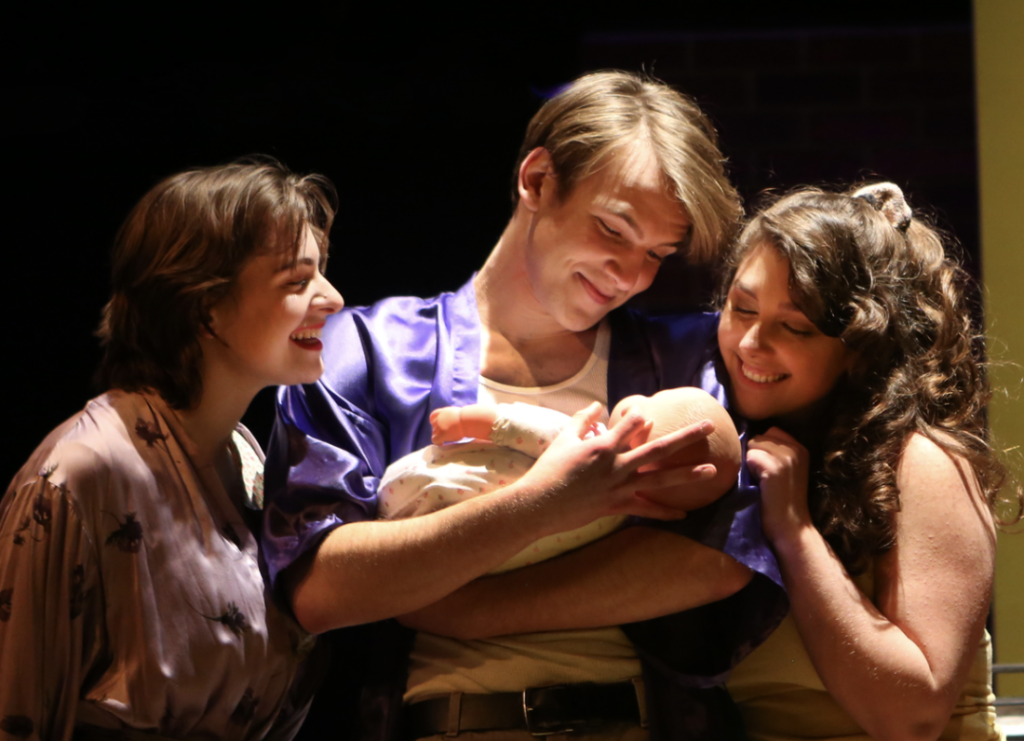By Julian Tushabe ’22
This spring, Skidmore Theater did something different from their typical season by putting up two Black Box productions in rep: And Baby Makes Seven, written by Paula Vogel, and directed by Gemma Siegler, ‘22, and The Chaparral, written and directed by Tatsu Rivera ‘22.

In And Baby Makes Seven we saw Anna, (played by Lilianna Mastroianni ‘22), Ruth (played by Emily Zeller ‘22), and Peter (played by Jonah Harrison ‘22), eagerly awaiting the arrival of their newborn child. The threesome navigates all of the emotions that come with pregnancy and parenting through the lens of three imaginary children played by the women.

The Chaparral took us to the open road in a shrubland plant community where Jean (played by Austin Brannan ‘23) struggles with his identity as a queer man and flees from home with the company of his sibling Alexis (played by Sophie Kelly ‘24). Each night the shows alternated as to which one would go up first with a brief intermission between the two, where the space was impressively transformed.
For The Chaparral, the audience walked in and sat parallel to each other with the stage between them where Jean and Alexis were already driving silently down the road in a bright red Nissan, with Fern (played by Izzy Maher ‘22) in the backseat. The play opened up with Alexis pointing out every plant they saw on the side of the road for Jean to identify, but through various interactions with different characters the siblings meet as they get lost in the chaparral, Jean is forced to reckon with his queerness. Somewhere near the end, Jean and Fern watch a beautiful montage of scenes from queer films projected on screens at both ends of the stage before finally taking Alexis to the “mud show” that they’ve been begging to visit. The play ends with Alexis shooting an unseen figure, implied to be the person they fled from, represented by a pulsing image on one of the screens, and yelling out “fuck nazis,” a callback to a story they told about their grandfather.

And Baby Makes Seven took us to the inside of a 1980’s New York City apartment with tiled floors, a kitchen, and a fire escape where Ruth and a very pregnant Anna hilariously blurred the lines of reality and illusion with frequent switches into the characters of their three imaginary children, much to Peter’s dismay. Through numerous quick changes in wardrobe, physicalities, and dialects, Anna and Ruth continually dive deeper into the personalities of their imaginary children until Peter’s frustration forces them to consider the ways this behavior may be unhealthy. They eventually decide to kill each of the children off to make space for their baby on the way but struggle to release the comfort the kids had brought them. The tensions and intimate moments in the process of releasing their imaginary children ultimately leads to a beautiful family dinner scene after the arrival of their baby where Peter decides to bring the imaginary children back.

Through the dynamics between the threesome in And Baby Makes Seven and the two siblings in The Chaparral definitions of family, power, masculinity, femininity, friendship, and love, are explored and challenged in clever, comedic, and heartwarming ways.
***
Julian Tushabe ’22 is a Staff Writer for the Skidmore Theater Living Newsletter
